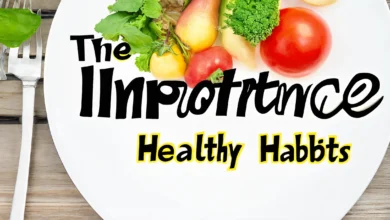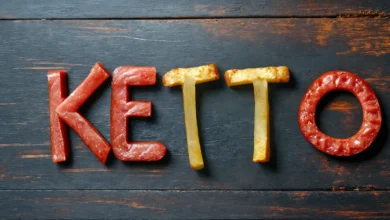The Ultimate Guide to Starting and Succeeding With a Low-Carb Diet

Embarking on a low-carb diet? Let’s slice through the dough of misinformation and butter you up for success with “The Ultimate Guide to Starting and Succeeding With a Low-Carb Diet”.
This isn’t just another leaflet that sugar-coats the hardships; it’s a full-on, meaty guide designed to carve out the path of least bread-istance, ensuring your journey is as smooth as a mashed avocado.
Get ready to turn your back on the pasta-tive and embrace the high-steaks world of low-carbing. Because who needs spaghetti when you can spiralize your way into vegetable nirvana?
Understanding the Basics of a Low-Carb Diet
Diving headfirst into the world of low carb diet plans can feel like deciphering an ancient scroll—especially with terms like keto diet and Mediterranean diet tossed around like salad. Here’s the skinny: eating low-carb doesn’t mean you can only whisper sweet nothings to a steak. It’s about choosing your carb friends wisely and breaking up with the rest.
Now, you might wonder if you can just dip your toes in the carb diets pool without fully committing. Sure, a diet may allow some wiggle room, but to truly eat a low carb diet, think of high-carb foods as that ex who keeps texting you—it’s better to ignore them. Instead, by following a low carb diet, you’re essentially RSVPing ‘yes’ to a healthier lifestyle where carb foods are not the center of your plate’s universe.
Creating a diet plan that’s low in carbs might feel like prep for a space mission at first, but once you get the hang of it, you’ll see it’s not rocket science. It simply takes some patience, a passion for avocados, and a willingness to explore beyond the carb-laden horizon. So, buckle up, buttercup—the world of low-carb eating is ready to welcome you with open, toned arms.
What Constitutes a Low-Carb Diet?
People often ask, “What in the kale-infused world constitutes a low-carbohydrate diet?” Well, imagine your body, having shed 40 lbs of whatever it thought it needed, suddenly realizing it can thrive on less. Less glucose, that is. Your body stores are raided, and much like a good spring cleaning, toxins are released. This is the moment your body goes full Marie Kondo, sparking joy by using energy instead.
During this delightful metabolic soirée, one may find meal plans harder to stomach than the concept of a diet itself. High-quality proteins, fats, and yes, whole grains (gasp!), become the VIP guests. Watching a banana become persona non grata while an almond takes its spotlight can indeed cause a digestive upset. But fear not, as this shift also allows for an astounding alchemy where your body is used to channeling fats for fuel, leaving you less hangry and your appetite more manageable.
Yet, amidst the culinary shuffle, people find the need for a pinch of magic in the form of a mineral or two and a robust meal prep routine to ensure they can digest their newfound dietary freedom without summoning the spirit of the dreaded carb. Thus, embarking on this gustatory quest not only reshapes one’s physique but reshuffles the edible deck, placing energy and satisfaction at the forefront.
Different Types of Low-Carb Diets: Keto, Atkins, and Paleo
When venturing into the low-carb jungle, you’ll encounter beasts of various stripes – Keto, Atkins, and Paleo, each with its unique dietary dogma. Keto swears by the mantra of high fat, insisting that cheese is not just a snack, it’s a lifeline. Then there’s Atkins, which plays a sly game of reducing your carb intake consistently, tricking your body into thinking pasta was just a bad dream. Paleo, the dietary equivalent of time travel, insists that if a caveman didn’t eat it, neither should you. So, choose your low-carb adventure wisely!
The Science Behind Carbs and Weight Loss
Let’s talk science, shall we? The curious tale of carbs and weight loss is not just your average bedtime story. It consists of plot twists, deceit, and a bit of magic. What if I told you that not all carbs are the evil villains in your quest for a slimmer waistline? Yes, some are sneaky, masquerading as healthy options while plotting to expand your waistline. But others? They’re the unsung heroes in this saga, offering energy and satisfaction without the betrayal. So, before you banish all carbs to the shadow realm, remember, knowledge (and moderation) is power.
Starting a Low-Carb Diet the Right Way
Embarking on the quest to lose weight often looks like bidding adieu to everything sweet (yes, even staring down that sugar with betrayal in your eyes). But let’s spice up that farewell with a sprinkle of wit. Starting a low-carb diet may initially feel like you’re forsaking every calorie for a higher cause, but it’s less about giving up and more about swapping. Ease into this diet slowly, as diving headfirst into the ketogenic diet ocean can shock your system faster than a carb lover’s first encounter with zucchini noodles.
Remember, going on a low-carb escapade is not just about cutting back on carbohydrates; it’s about embarking on a delightful (read: bearable) journey to ketosis. Yes, that revered state where your body, missing its carb buddies, turns to fat for fuel. Imagining your body throwing a fat-burning party can be quite motivating. So, take it easy, and remember, every slice of bread skipped is a step closer to your goals. Who knew that chasing ketosis could be this amusing, right?
How to Gradually Reduce Your Carb Intake
Embarking on the less-carb-more-remarkable journey? First, let’s clarify that carbohydrates are not entirely the villain in your dietary plot twist; they’re just misunderstood extras craving a bit of spotlight. So, how do you gently nudge them off the stage? Begin by swapping your regular white bread serenades with whole grain solos. They’re like the indie band that’s way cooler but hasn’t hit mainstream yet.
Next, trick your sweet tooth with a bit of sleight of hand. Instead of reaching for that sugar-dusted doughnut, find solace in fruits. Yes, fruits – nature’s candy, or as I like to call them, guilt-free guilty pleasures. Last but not least, introduce more vegetables into your meals. They should not just be a side act but the main event. Slowly, your plate will transform into a vibrant canvas worth of a food blogger’s Instagram, minus the carbs lurking in the shadows.
Key Foods to Eat on a Low-Carb Diet
Welcome to the exclusive club of low-carb enthusiasts, where sugar is practically a swear word, and carbs are the nosy neighbors we kindly ignore. The VIPs here are glorious meats and cheeses, taking the spotlight on our plates with the confidence of a peacock. But let’s not forget about the unsung heroes in this culinary symphony – the leafy greens. Yes, greens like kale and spinach are not just for rabbits; they’re our low-carb superstars, dancing gracefully alongside avocados and olive oil in a ballet of fats and fibers. So, as you embark on this noble quest of low-carb living, arm yourself with these essentials, and you’ll never fear a carb again.
Common Mistakes When Starting a Low-Carb Diet
Ah, the low-carb diet, a path many tread with dreams of melting away those extra pounds, only to stumble on the pebbles of pitfalls along the way. Perhaps the most laughable misstep is the blind trust in “low-carb” labels. Much like a siren’s call, these labels often lure unsuspecting dieters into the rocks of hidden sugars. Then, there’s the rookie mistake of not drinking enough water. Yes, we’re cutting carbs, not hydrating like a cactus in the desert. Remember, your body isn’t just shedding carbs; it’s saying farewell to water weight, so keep the aqua flowing.
Another amusing oversight is ignoring the importance of vegetable intake. Embarking on a low-carb journey without veggies is like setting sail without a map; sure, you might float, but you’re probably not going to end up where you want to be. And last but not least, the grand illusion of assuming all fats are created equal — spoiler alert: they’re not. Swapping out processed foods for whole, unadulterated fats is the heart of the matter. So, let’s navigate the low-carb voyage with a bit more wit and wisdom, shall we?
Creating a Meal Plan That Works
Before you leap into starting any diet that promises you’ll turn into a Greek deity overnight, remember that creating a Meal Plan That Works is akin to a fine art. If you’re eyeing those high carb delights while wrestling with type 2 diabetes, it’s time to get started on a plan that doesn’t lead to culinary sin.
It’s all about balance, darling. Ways to start include swapping out that sugar-loaded morning joe for something less coma-inducing. Then, you can start eating like someone who wants their body to start burning fuel efficiently rather than someone prepping for hibernation. It may help lower the drawbridge over the moat of metabolic syndrome, letting you storm the castle of well-being with gusto.
Designing a Balanced Low-Carb Meal Plan
Embarking on the quest to design a balanced low-carb meal plan is akin to becoming a nutritional ninja. First, you must stealthily navigate the carb-laden landmines of modern cuisine.
Arm yourself with leafy greens and lean proteins, your katana and shuriken in the shadowy world of macros. Remember, the art of crafting such a plan requires the precision of a sushi chef and the balance of a tightrope walker.
High-Protein, Low-Carb Foods to Incorporate
Oh, the high-protein, low-carb diet, the savior of beach body aspirants and the bane of bagel lovers everywhere. Among the elite ranks, the chicken breast, stripped of its flavorful skin and juiciness, reigns supreme. It’s not just a meal; it’s a commitment to living a life where joy is measured in muscle definition.
Let’s not forget the eggs, nature’s protein-packed orbs of goodness, versatile enough to adapt to any meal, assuming you’re okay with your cholesterol playing a game of roulette. And for the vegetarians out there, fear not, for tofu stands ready to blandly save the day, absorbing the flavors of its more exciting, though carb-laden, friends. So, embark on this culinary journey where every bite is a step away from carbs and a leap toward a guilt-free, albeit somewhat less jubilant, existence.
Vegetables and Fruits: Understanding Carb Content
Delving into the world of vegetables and fruits to understand their carb content can feel a bit like becoming a botanical accountant. You start categorizing your greens and reds with the meticulousness of a tax audit. On one hand, vegetables march in, proudly low in carbs, making them the unsung heroes of the low-carb enthusiast.
Flip the page, and fruits enter the fray, a mixed bag where some are sugary villains in disguise, while others are allies in your quest for health, offering just the right carb count to fuel your day without going overboard. Navigating this landscape requires wit, patience, and perhaps a calculator for those tricky moments when you’re trying to figure out if a banana is friend or foe today.
Overcoming Challenges: From Keto Flu to Carb Cravings
Embarking on a quest to beat obesity and shed weight quickly can be as thrilling as finding jeans that fit on the first try. However, whisper it, you might need to chat with your doctor before starting, lest you get ambushed by the infamous keto flu or its villainous sidekick, carb cravings. Picture this: You, a valiant warrior armed with meat, nuts, and the dreams of quinoa fields, marching against the sugary empire of flour and deceit.
Yet, it’s a journey, one where your body starts drafting “I miss carbs” letters faster than a politician’s excuses. It’s an epic saga of metabolic flexibility, where the keto flu looms large like a beast from legends, ready to test your resolve. But fear not! With every wisp of bread that passes ungrasped, your will fortifies. Seeking sage advice on incorporating a nutritional balance could lead you to victory without sacrificing your soul to a life devoid of all things grain. After all, victories aren’t just etched in lost pounds but in overcoming the whispering ghosts of carbs past, with perhaps a little help from the likes of cheese, eggs, et al.
Managing Symptoms of the Keto Flu
Ah, the keto flu, nature’s way of asking, “How bad do you really want those abs?” So, you’ve decided to turn your body into a fat-burning machine, but now you’re feeling like a vintage car trying to start on a cold morning. Fear not!
Hydration is your new best friend; think of water as your body’s personal IT department, fixing bugs. And don’t forget electrolytes; they’re like the secret sauce that keeps everything running smoothly. So, grab that salt, potassium, and magnesium, and let’s get you back to feeling like a well-oiled, carb-dodging machine!
Strategies to Handle Cravings for High-Carb Foods
When the siren song of potato chips beckons, outsmart hunger by negotiating with almonds or cheese cubes instead. They’re like your taste buds’ savvy lawyers, offering a better deal.
And when a sugary cereal commercial whispers sweet nothings, retaliate with the crunch of a protein-packed omelet. It’s the culinary equivalent of choosing a lasting romance over a fleeting crush.
Lastly, trick your palate into thinking it’s indulged by crafting a smoothie that tastes naughty but is oh-so-nice. It’s like the Trojan Horse of snacks; your cravings won’t know what hit them.
Staying Hydrated and Maintaining Electrolyte Balance
Let’s talk about the equivalent of finding the secret sauce in the realm of bodily functions – staying hydrated. This isn’t your average H2O PSA. No, we’re diving deeper, right into the electrolyte pool.
Think of maintaining electrolyte balance as being the DJ at your body’s internal rave. Too little, and the party’s a snooze fest. Too much, and it’s an out-of-control foam party. The goal? Keep those vibes just right, ensuring you’re not only hydrated but harmoniously balanced.
Incorporating Healthy Fats and Proteins
For those of you used to eating a diet that’s more mac & cheese than macronutrients, incorporating healthy fats and proteins may sound like a culinary mission impossible. Fear not! The transition doesn’t require a complete kitchen overhaul—just a willingness to explore alternative sources of these dietary superheroes. Think of it as swapping your fries for veggies that actually taste good with a sprinkle of sea salt and a dash of vinegar.
But why bother? Well, for starters, adequate intake of these nutrients helps you burn fat like you’re on a covert operation to maintain your sleek agent physique. Plus, there’s nothing quite like the mood-lifting, energy-sustaining power of a meal that’s well balanced in fats, particularly those of the omega-rich variety. These essential fatty acid operatives work inconspicuously in the background, ensuring your body runs smoother than a spy evading capture.
In conclusion, if you may want to stay ahead in the nutrition game without feeling like you’re gnawing on cardboard, consider this approach your secret mission—should you choose to accept it. The beauty of it all? You can still enjoy the occasional indulgence without the guilt. Because let’s face it, life’s too short not to enjoy the feast.
The Role of Fats in a Low-Carb Diet
Think of fats in a low-carb diet as the unsung heroes, quietly stepping into the spotlight as carbs take a bow and exit stage left. These nutritional powerhouses fill the void, ensuring that your energy levels don’t dip faster than a stock on Wall Street. They’re like the reliable friend who has your back, providing satiety and flavor, proving once and for all that not all heroes wear capes.
Indeed, embracing fats while shunning carbs is like finally giving the microphone to the backup singers—the real talent behind the scenes. They not only make meals more enjoyable but also keep you feeling full, so you’re not rummaging through the fridge at midnight looking for a snack. In essence, fats in a low-carb diet are the cool aunt or uncle of the nutritional world, showing up with the goods when you need them the most.
Lean vs. Fatty Proteins: What to Choose
In the grand culinary coliseum, where lean proteins and fatty proteins battle for supremacy, choosing sides can be quite the conundrum. On one corner, lean proteins strut their low-fat content like it’s a fashion statement, whispering promises of a trimmer waistline and a guilt-free conscience.
Meanwhile, fatty proteins lounge on the other side, smug in their rich, flavor-packed glory, assuring you that life’s too short for bland meals. The plot thickens as one realizes that this is not just about taste vs. health. It’s a saga of balance. So, why pick a side when you can have the best of both worlds? Embrace the middle ground – it’s juicier there.
Nuts, Seeds, and Dairy: Selecting the Best Options
When embarking on the perilous journey of selecting the ultimate nuts, seeds, and dairy, remember not all heroes wear capes. Some just have a keen eye for the freshest almonds and the creamiest cheese. So, gird your loins, because in this grocery gladiator arena, only the most discerning taste buds survive.
Making it Stick: Sustaining Your Low-Carb Lifestyle
Embarking on a low-carb lifestyle isn’t just about cutting out the baguettes and saying bonjour to more bacon; it’s a meticulous dance with your insulin levels and keeping your blood sugar as steady as a tightrope walker. To those eyeing this culinary tightrope, remember, you’re going to need balance and a touch of bravado. Sure, ditching the carbs for a fat-burning fiesta sounds grand, but it’s like telling the yeast in your gut they’re on a permanent vacation—unsettling but oddly satisfying.
Adapting to a life where bread is basically a swear word doesn’t mean you’ll wake up feeling like a Greek god ready to sprint up Mount Olympus. In the early days, your body may not be the best at swiveling to its new fat-burning jet fuel, just as you get used to the idea that the only rolls you’ll see are those of the flesh variety as you bid adieu to the doughy kind. And let’s not forget the temporary mutiny from the yeast in your gut, reminiscing over the good ol’ carb-laden days. Ah, the journey of less carbs and more sass!
Adjusting Your Diet for Long-Term Success
So, you’ve decided to adjust your diet for long-term success. Congrats! Step one is to wave a not-so-fond farewell to those late-night cheeseburger rendezvous. Embrace the art of munching on greens like you’re a star in a salad commercial. It’s about balance, not deprivation. You’re not saying goodbye to flavor, you’re just cheating on processed food with fruit and veggies. Sneaky, right?
Benefits of Combining Low-Carb Eating with Exercise
Combining low-carb eating with exercise is like Batman and Robin teaming up to save Gotham from bad nutrition and lethargy. It’s the dynamic duo of weight management.
While low-carb diets stealthily reduce your reliance on sugar, turning you into a fat-burning machine, exercise swoops in to boost your metabolism and muscle tone faster than you can say “avocado”.
When to Consult a Professional: Navigating Health Concerns
When the sniffles transform into a symphony only your sinuses could compose, it’s time to consult a professional. If your body is sending more signals than a desperate castaway, deciphering them shouldn’t be a DIY project. Navigating health concerns without an expert is like trying to assemble IKEA furniture without the manual – theoretically possible, but why torture yourself?





